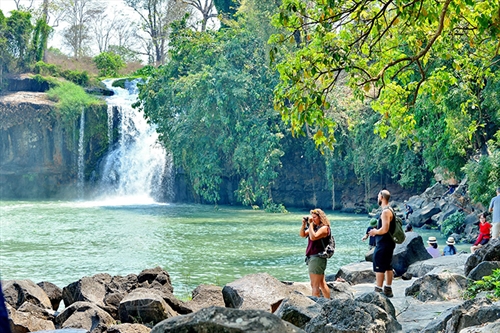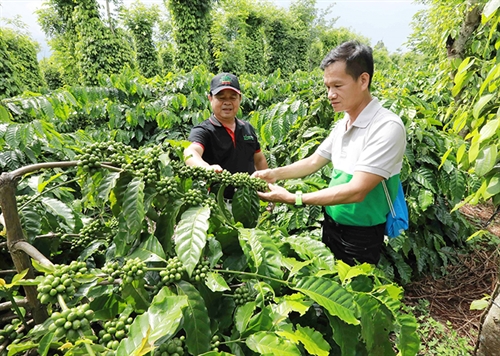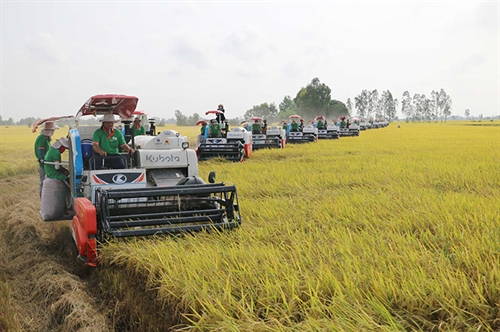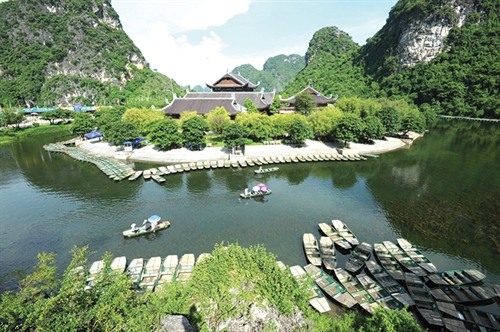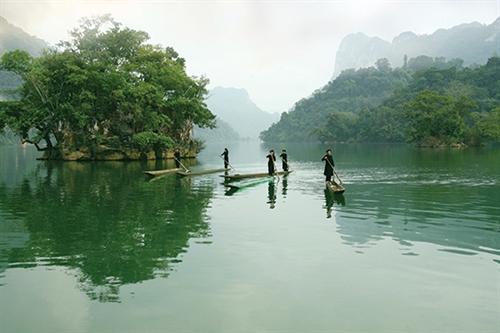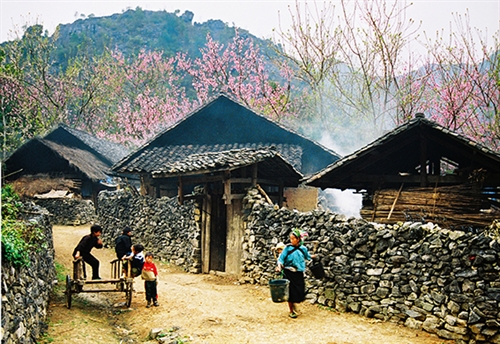Located in the northwestern region of the country, Dien Bien mountainous province is the only locality that shares a 455-kilometer borderline with Laos and China. It borders Son La province to the east and northeast, Lai Chau province to the north, China’s Yunnan province to the northwest, and Laos’ Phongsaly and Luang Prabang provinces to the west and southwest.
The province is now accessible by road and air. It is linked with Hanoi by national highway 6, Lai Chau province by national highways 12 and 279 and eight other northern mountainous provinces - Quang Ninh, Bac Giang, Lang Son, Bac Kan, Tuyen Quang, Ha Giang, Lao Cai, and Son La by national highway 279.
Transport infrastructure development has been considered one of the keys to open opportunities for attracting investment in the province and creating a breakthrough in its socio-economic development. The provincial authorities have mobilized investment sources for synchronously completing modern infrastructural facilities. Worthy of note, the Dien Bien airport expansion project was launched in January, 2022, and is expected to be completed this November. Once completed, the expanded airport would be able to accommodate modern aircraft such as A320 and A321, and serve up to 500,000 passengers a year. In addition, the province has proposed the Government to invest in building the Son La-Dien Bien-Tay Trang border-gate expressway section on the Hanoi-Hoa Binh-Son La-Dien Bien expressway. It is also planning to upgrade the Dien Bien-Tay Trang border gate (with Laos) section of national highway 279, a section linking national highway 4H with A Pa Chai crossing (with China).
Dien Bien has great renewable energy potential with over 2,000 hours of sunlight per year and a wind speed of 7-10 m/s at the height of 100 meters which is ideal for solar and wind power development. It also boasts huge swathes of unused fertile land and untouched forestland areas that are expected to meet the requirements of forestry and farm production. The province is home to more than 350,000 hectares of forests and the 150-square kilometer Muong Thanh paddy field, the biggest one in the northwestern region. Thanks to the advantage of soil and climate, the province’s rice productivity and quality are high and special. It has also developed large areas under macadamia, rubber, coffee and tea with more than 4,220 hectares of macadamia, 5,010 hectares of rubber, 2,640 hectares of coffee and 613 hectares of tea.
Despite several advantages, so far the province has only one foreign direct investment (FDI) project - the USD 3.3-million cassava powder processing plant invested by China, according to Nguyen Van Toan, deputy head of the External Economy Division of the Department of Planning and Investment.
To attract more FDI in the province and tackle obstacles for investors, conferences between provincial authorities and investors are held twice a year, Toan added.
Addressing the first conference between provincial authorities and investors in early April, Secretary of the Dien Bien Party Committee Tran Quoc Cuong said that local authorities at all levels would continue standing side by side with, providing support to, and creating favorable conditions for, investors to carry out production and business investment activities in the locality. They will create a fair business climate to increase the number and expand the scale of enterprises, he added.
Apart from improving the provincial competitiveness for the 2021-25 period, the province will focus on administrative reform, improve business and investment environment and shorten time for completing tax and customs formalities, Cuong told the conference participants.
Dien Bien is also striving to be listed among the top 20 localities in the 2023 Satisfaction Index of Public Administration Services (SIPAS) and Public Administration Reform (PAR) index and in the low average group in the 2023 Provincial Governance and Public Administration Performance Index (PAPI).
At present, the locality is calling for FDI in planting organic vegetables, medicinal herbs and macadamia trees and in cattle and poultry raising and slaughtering facilities. Other projects calling for investment specialize in community-based tourism and coffee growing and processing.
In addition to attracting investment for local socio-economic development, Dien Bien aims to develop tourism into a spearhead economic sector, creating an impetus for growth and economic restructuring of the province.
The objective was set out in the Dien Bien Party Committee’s Resolution 03-NQ/TU of 2021 on the province’s tourism development through 2025, with orientations toward 2030.
Accordingly, Dien Bien will be built into an attractive tourist destination in the northern midland and mountainous region by 2025 on the basis of effectively exploiting potential and strengths associated with the conservation and preservation of ethnic groups’ cultural identities, historical relics, protection of ecological environment and improvement of the material and spiritual life of local people.
By 2025, the tourism services’ added value will contribute 10 percent to the province’s gross regional domestic product (GRDP); the average length of stay of tourists in the province will be three days or more and the number of tourists to the province and tourism revenues will rise by 15 percent per year.
The hospitality plans to lure investors and economic groups into building hotels so that at least two luxurious hotels and two resorts will be put into service by 2025. In addition, it will provide support to local enterprises and business households in building hotels and guesthouses and call for investment in building multi-functional amusement parks in expanded Dien Bien Phu city as well as a safari park.
The tourism sector will also focus on developing historical and spiritual tours to national relics, particularly the Dien Bien Phu battlefield, and eco-cultural tours exploring the cultural identities of 19 local ethnic groups. Community-based tourism products exploring natural landscapes and recreation and entertainment tourism products will also be developed.-
| Provincial facts Land area: 9.540 sq. km Administrative units: Dien Bien Phu city, Muong Lay town and the eight districts of Dien Bien, Dien Bien Dong, Muong Ang, Muong Cha, Muong Nhe, Tua Chua, Tuan Giao and Nam Po Population: around 625,090 (the 2021 statistics) Ethnic groups: 19 ethnic groups with the H’Mong being the most populous, representing 38 percent of the province’s population, followed by Thai (35.7 percent) and the Kinh (Viet) (17 percent) and others Socio-economic figures - Export turnover: some USD 18.74 million in the first quarter of 2023 - Main exports: construction materials and farm produce (mainly pomelo and fresh ginger) - GRDP: VND 13.9 trillion (USD 582 million) in 2022 with a year-on-year increase of 10.9 percent; and a rise of 6.7 percent in the first quarter of 2023 - Farm produce bearing geographical indications: two rice varieties - Bac Thom 7 and IR64 Tourism - Famous tourist attractions: - Dien Bien Phu historical complex with 45 relic sites such as: + The Dien Bien Phu Victory Museum + A1 Hill (called Eliane 2 by French troops) + Doc Lap Hill - Muong Nhe Nature Reserve - Pa Thom Cave - Kho Chua La Cave - Tham Khen Cave - Hua Pe Hot Spring - Pa Khoang Lake - Craft products: do (poonah) paper, khen (panpipe) and shoes and costumes made by the H’Mong - Travellers: over 810,000 in 2022 and 76,000 on two national holidays - Reunification Day (April 30) and May Day (May 1) - Tourist accommodations: 210 hotels and guesthouses, 11 cultural tourism villages, and six homestays - Festivals + Annual Bauhinia variegata (orchid tree) flowers festival + Festival of Culture, Sports and Tourism of the local ethnic groups + Ban Phu Citadel Festival (or Hoang Cong Chat Temple Festival) in commemoration of Thai hero Hoang Cong Chat who restored peace to the mountainous region almost 300 years ago (Source: http://dienbien.gov.vn; https://thongkedienbien.gov.vn/) |

